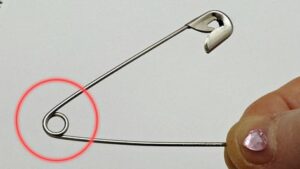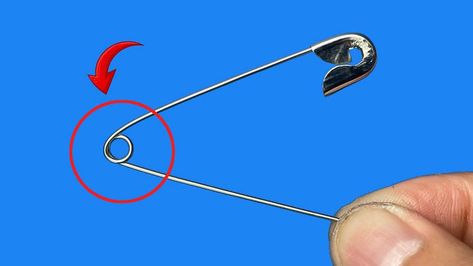Imagine this: you’re at a wedding dress fitting, and everything seems perfect—until you notice a tiny tear in the fabric near the hem. Panic sets in as your mind races through potential solutions. Will you need to cancel the event? Spend hours finding a tailor? Then, out of nowhere, the seamstress pulls a small silver object from her toolkit—a safety pin. Within seconds, she fixes the issue so seamlessly that no one would ever notice.
That moment left me stunned. How could something so simple solve such a big problem? It made me reflect on all the times I’d dismissed the safety pin as just another mundane item in my junk drawer. If only I had known earlier about its hidden powers, I might have saved myself countless headaches over the years. Now, it’s time to uncover the secrets of this unassuming tool together. What are these secrets, and why haven’t you been told sooner?

The History and Evolution of the Safety Pin
Who Invented the Safety Pin?
Let’s start by diving into the origins of the safety pin. Back in 1849, an American mechanic named Walter Hunt invented the modern version of this ingenious device. Hunt was looking for a way to secure clothing without causing injury, which led him to design a clasp with a coiled spring mechanism. Little did he know, his creation would go on to become one of the most versatile tools in human history.
At first, the safety pin served primarily as a functional accessory for garments. However, its utility soon expanded far beyond its original purpose. From wartime innovations to cultural symbolism, the safety pin has proven itself adaptable across different eras and contexts.
From Necessity to Versatility
Over the decades, the safety pin found new roles in various fields. Here’s a quick rundown of how it evolved:
- Wartime Utility : During both World Wars, soldiers relied on safety pins to mend uniforms, secure bandages, and even repair equipment.
- Cultural Symbolism : In the late 20th century, punk rock enthusiasts adopted the safety pin as a symbol of rebellion against societal norms. Bands like The Sex Pistols popularized its use in fashion.
- Modern-Day Applications : Today, people turn to safety pins for everything from crafting projects to emergency repairs. Its adaptability continues to surprise us.
Understanding where the safety pin came from gives you a deeper appreciation for what it can do now. But let’s move beyond history and explore how you can put this little wonder to work in your daily life.
Everyday Uses You Never Knew Existed
You may think of the safety pin as nothing more than a way to keep baby clothes closed or fasten badges onto shirts. While those uses are valid, they barely scratch the surface of what this humble tool can achieve. Below, we’ll break down some practical applications that will change the way you look at safety pins forever.
Fashion Fixes Everyone Should Know
Have you ever faced wardrobe malfunctions right before heading out the door? Safety pins can be your ultimate savior in these situations. Here’s a list of ways they can rescue your outfit:
- Repair Torn Seams Temporarily
If you notice a rip in your favorite sweater or skirt, grab a safety pin to hold the fabric together until you can get it properly stitched. - Create Adjustable Straps
Dresses or bags with straps that are too long? Use safety pins to shorten them discreetly without altering the garment permanently. - Secure Scarves and Shawls
Keep lightweight scarves or shawls in place by pinning them strategically. This prevents awkward slippage during windy days or formal events.
These tips aren’t just for emergencies—they’re great tricks to have up your sleeve anytime you want to tweak your wardrobe creatively.
Home Organization Hacks
Beyond fashion, safety pins can make your home tidier and more organized. Consider these ideas:
- Hang Lightweight Items : Use safety pins to hang keys, jewelry, or small decorations. Simply attach them to hooks or bulletin boards for instant storage.
- Tame Cords and Cables : Wrap unruly cords around a safety pin to prevent tangling. This works especially well for earbuds, chargers, and USB cables.
- Label Plants in Your Garden : Write plant names on paper tags and pin them to stakes or pots. This helps you stay organized while gardening.
With a few clever placements, you’ll find that safety pins can simplify your space significantly.
Emergency Survival Tool
In critical situations, having a safety pin handy can literally save the day. Check out these survival scenarios where it shines:
- Removing Splinters Safely : Sterilize a safety pin, then gently lift splinters out of your skin. It’s much safer than using tweezers if done carefully.
- Making Fishing Hooks : In dire circumstances, bend a safety pin into a hook shape to catch fish. Pair it with string or wire for makeshift fishing gear.
- First Aid Solutions : When medical supplies are scarce, use a sterilized safety pin to close minor cuts temporarily. (Note: Always seek professional care afterward.)
While you hopefully won’t encounter these scenarios often, knowing how to utilize a safety pin in emergencies adds peace of mind to your preparedness kit.
Surprising Non-Traditional Uses of the Safety Pin
If you thought we’d covered all there is to know about safety pins, think again. These versatile tools also play a starring role in creative pursuits like crafting and artistry. Let’s explore how you can incorporate them into your next project.

